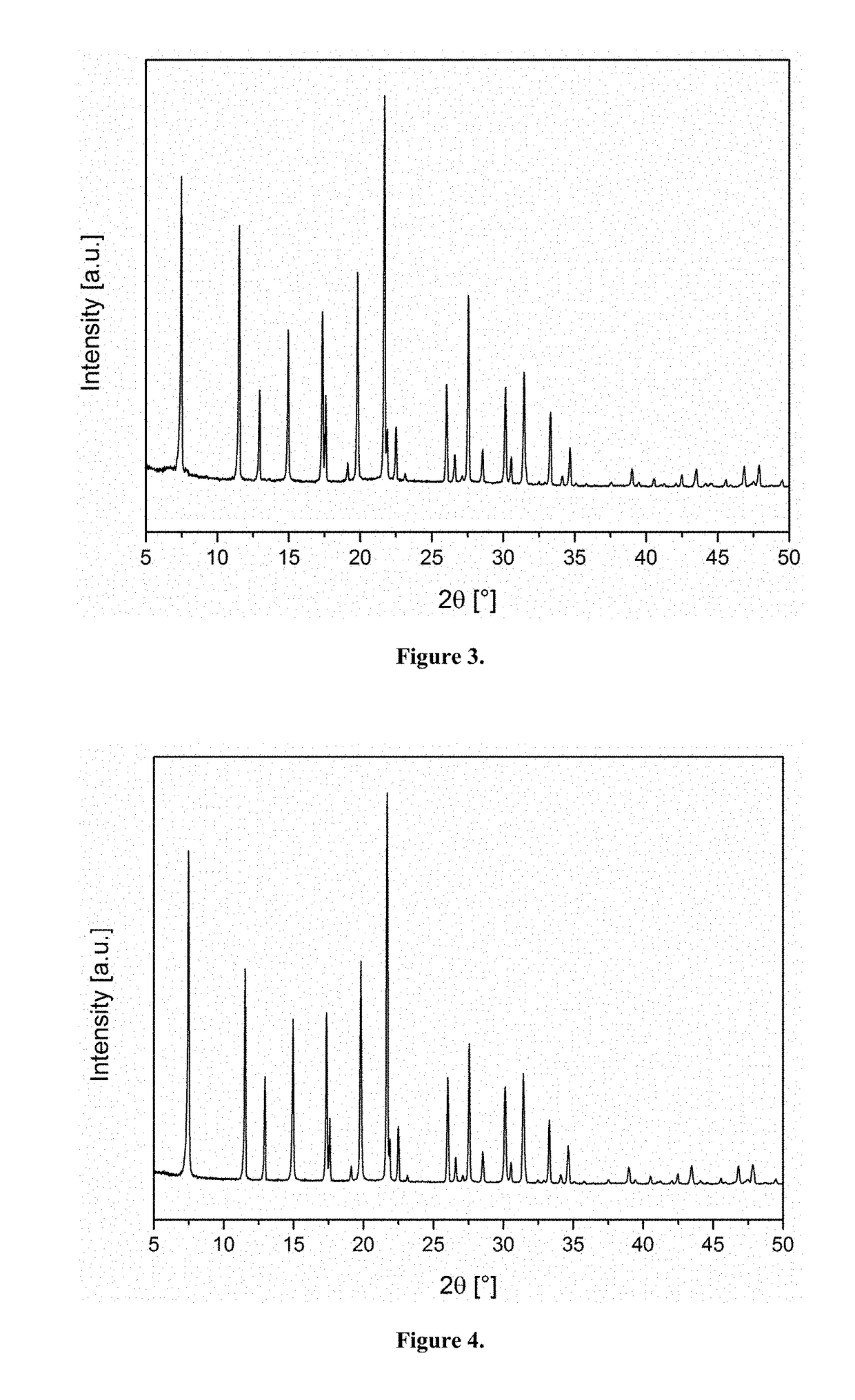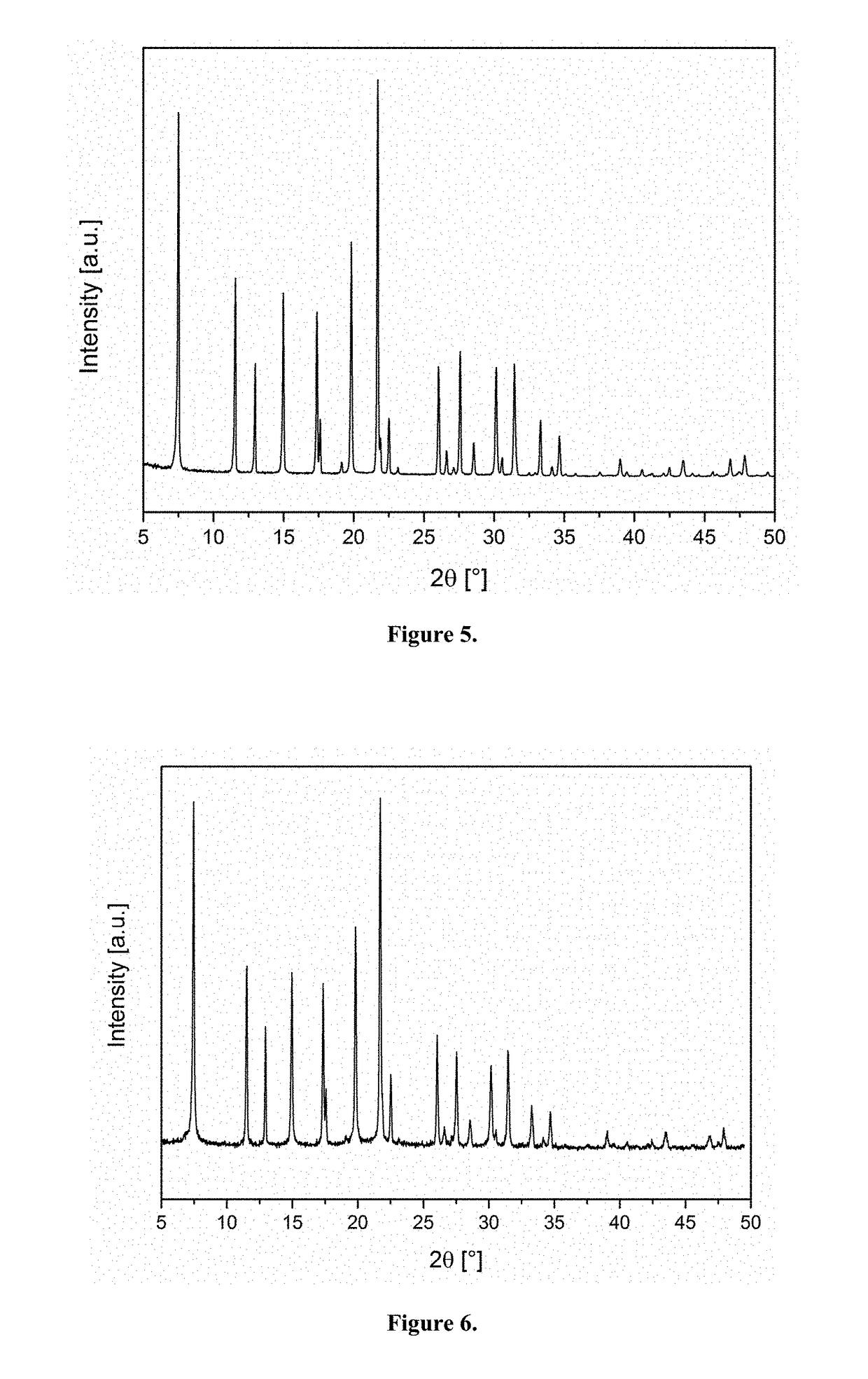Sta-19, a new member of the gme family of molecular sieve zeotypes, methods of preparation and use
a technology of molecular sieves and zeotypes, which is applied in the field ofsta19, a new member of the gme family of molecular sieve zeotypes, can solve the problems of acidity of materials and imbalance of charges
- Summary
- Abstract
- Description
- Claims
- Application Information
AI Technical Summary
Benefits of technology
Problems solved by technology
Method used
Image
Examples
example 1
of olig-(1,4-diazabicyclo[2.2.2]octane)-pentyl dibromide ([DABCO-C5]3)
[0232]21.0 g (0.09 mol) of 1,5-dibromopentane was dissolved in 50 mL ethanol and added to a solution under stirring at 50° C. of 12.3 g (0.11 mol) of 1,4-diazabicyclo[2.2.2]octane (DABCO) dissolved in 100 mL ethanol. The mixture was refluxed for 24 hours, then the mixture was brought to room temperature and excess of ethanol was removed on a rotary evaporator, leaving a white solid. The solid was washed with cold diethyl ether, acetonitrile and acetone and dried at 50° C. overnight. The reaction formed 25.30 g (yield 76%) of product which was analysed by NMR and elemental analysis. The number of repeating units was calculated using the ratio between the integration of the 1H NMR peak associated to the di-protonated DABCO and the terminal DABCO.
example 2
of olig-(1,4-diazabicyclo[2.2.2]octane)-hexyl dibromide [DABCO-C6]3)
[0233]20.1 g (0.08 mol) of 1,5-dibromopentane was dissolved in 50 mL ethanol and added to a solution under stirring at 50° C. of 11.0 g (0.10 mol) of 1,4-diazabicyclo[2.2.2]octane (DABCO) dissolved in 100 mL ethanol. The mixture was refluxed for 24 hours. Once cold, the excess of ethanol was removed on a rotary evaporator leaving a white solid. That was washed with cold diethyl ether, acetonitrile and acetone and dried at 50° C. overnight. The reaction yields 26.94 g (yield 89%) of product which was analysed by NMR and elemental analysis. The number of repeating units was calculated using the ratio between the integration of the 1H NMR peak associated to the di-protonated DABCO and the terminal DABCO.
[0234]The pH of the reaction gels in the Examples below was about pH 7.
example 3
of STA-19 Using Trimethylamine and [DABCO-C5]3
[0235]A reaction gel having a molar composition:
0.3 SiO2:1 Al(OH)3:0.7 H3PO4:40 H2O:0.15 [DABCO-C5]3:0.42 trimethylamine: 0.12 tetrabutylammonium hydroxide, and 4 wt. % of SAPO-GME seeds
was prepared in 30 mL pressure vessel. The reagents used and order of addition was:[0236]a) The required amount of phosphoric acid (H3PO4 85 wt. %, BDH) was weighted into a Teflon liner.[0237]b) The required amount of silica (fumed silica powder 0.007 μm, Sigma Aldrich) and water were added to the phosphoric acid and stirred.[0238]c) The required amount of aluminium hydroxide (Al(OH)3, Sigma Aldrich) was added to the above mixture.[0239]d) After stirring for 30 minutes, [DABCO-C5]3 (See Example 1) was added.[0240]e) Trimethylamine (45 wt. %, Sigma Aldrich) was added over the above solution and the mixture was stirred for 10 minutes.[0241]f) Tetrabutylammonium hydroxide (40 wt. %, Sigma Aldrich) was added to the mixture.[0242]g) 4 wt. % of SAPO-GME seeds ...
PUM
| Property | Measurement | Unit |
|---|---|---|
| Time | aaaaa | aaaaa |
| Time | aaaaa | aaaaa |
| Time | aaaaa | aaaaa |
Abstract
Description
Claims
Application Information
 Login to View More
Login to View More - R&D
- Intellectual Property
- Life Sciences
- Materials
- Tech Scout
- Unparalleled Data Quality
- Higher Quality Content
- 60% Fewer Hallucinations
Browse by: Latest US Patents, China's latest patents, Technical Efficacy Thesaurus, Application Domain, Technology Topic, Popular Technical Reports.
© 2025 PatSnap. All rights reserved.Legal|Privacy policy|Modern Slavery Act Transparency Statement|Sitemap|About US| Contact US: help@patsnap.com



